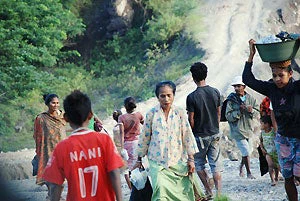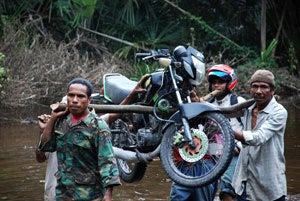 |
| People from Zulo Village, in the Zumalai sub-district, are going to market on foot due to landslides. |
In May this year, Timor-Leste marked a decade of its independence by celebrating much progress across many sectors, which has led to an improvement in many people’s lives. However, during the period since independence, the road network has seen very little improvement, other than some work on the main road along the border with West Timor and emergency repairs to “dig and cover the holes”, as people say, at discrete locations as the need arises. According to a survey of road conditions in 2009, many roads within the national road network have severely deteriorated.
I travelled to the rural areas of Aileu, Ainaro, Manufahi and Covalima District to see the road condition firsthand. It was a long, long trip, mostly due to the road condition rather than the distance itself – it took between 3 to 4 hours to travel 70 kilometers. The road conditions were so bad, in certain places drivers perform maneuvers impossible for people unfamiliar with the region. Parts of the road became virtually impassable for most of the year due to rain and land-slides. Communities living in already remote rural areas are increasingly becoming more isolated, vehicle movement is decreasing and transport costs are increasing.
I stopped to talk with drivers, passengers of local buses and communities living on or near the main roads.
 |
| Rain and flooding make travelling conditions even worse. |
Joel Jonathas is a bus driver and has been driving a bus from Dili to Ainaro since 2000. “I have spent more than ten years driving along this road, which has often been a bitter experience. But the road is everything for me. I serve my family with this road, my life and my family depends on it”.
“Sometimes we have to spend a night with passengers on the road. People cannot access the market on time during market day and their goods get spoiled. Sometimes we as the drivers have to charge double price due to the road condition when the tires and the vehicle get damaged”.
This current state of the road network not only affects economic activities of people living along the north-south corridor. When I spoke with Maria Madalena, the head of a local NGO based in Ainaro, she told me a tragic story. She said that the poor road condition sometimes has a fatal impact on the communities. One of her cousins lost her baby when the ambulance arrived too late and it took too long to get the hospital when she was delivering her baby."Maternal mortality rates in Timor-Leste are among the highest in the world. There are various reasons contributing to this high figure but in many communities poor road conditions play a role.
Building a robust road network is a priority for the Government of Timor-Leste, with connective infrastructure a pillar of the twenty year Strategic Development Plan. Alongside other donors like the Asian Development Bank (ADB) and the Japan International Cooperation Agency (JICA), the World Bank is supporting the government in helping rehabilitate the road network.
The Road Climate Resilience Project and proposed additional financing project will aim to rehabilitate the 110km road corridor from Dili to Ainaro, which passes through and connects three districts—Dili, Aileu and Ainaro, which jointly account for approximately one third of the Timorese population. This road serves as a vital link between the north and the south of the country, in some of the poorest and most remote parts.
 |
| Students from Zulo village walking to school. |
One of the main challenges is to manage risks of erosion and inadequate drainage facilities in order to ensure that the roads can withstand rain and flooding. The project will rehabilitate the road surface, while improving slope stabilization and drainage structures. It will also conduct routine maintenance activities such as grass cutting, drain clearing, pothole patching and shoulder repairs to prolong the life of the road and to mitigate potential deterioration
A new and pioneering study is also exploring the introduction and implementation of bioengineering to protect against landslides, using plants to fill engineering functions. “Soil bioengineering is now widely used for slope stabilization and soil conservation in many countries that experience slope instability”, said Dr. Bashir Hussain Shah who is working on the project.
Looking forward, an improved and more resilient road will give more people in some of the poorest parts of the country better access to markets to sell their produce.
More children will have better access to schools to receive the education they need and more people will be able to receive medical attention when they need it most, and in time to save lives.


Join the Conversation